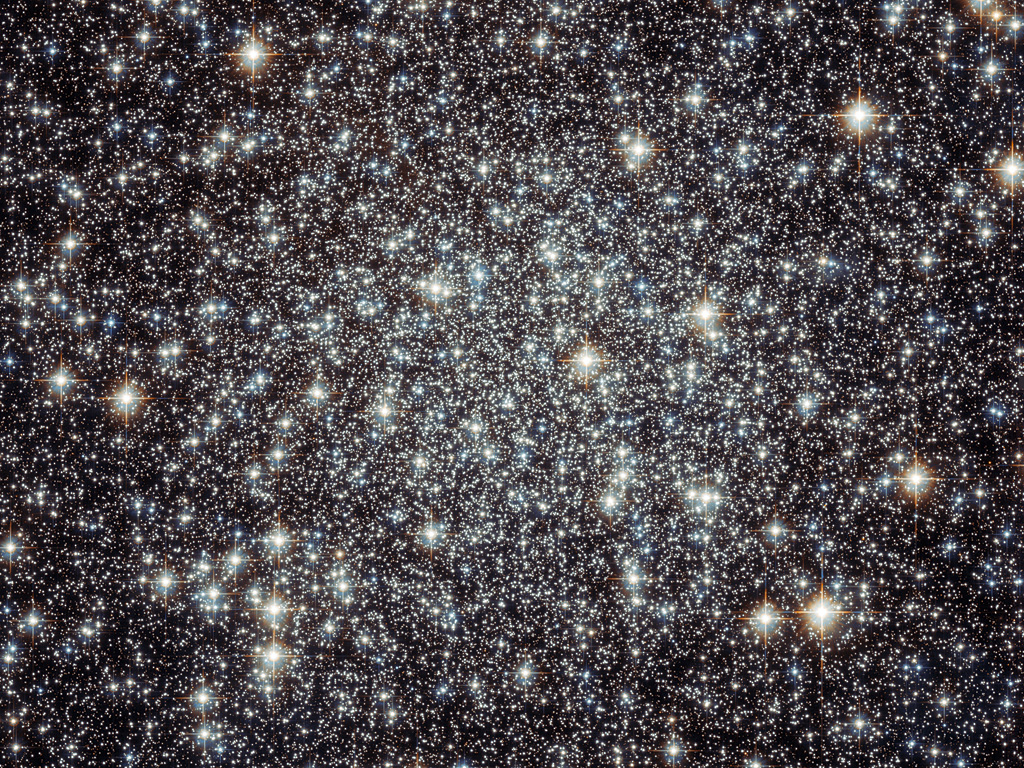
The Moon is the “star” of the sky this week, going from just past first-quarter through full, and having close encounters with several stars – this ought to make the Moon a great observing target all week!
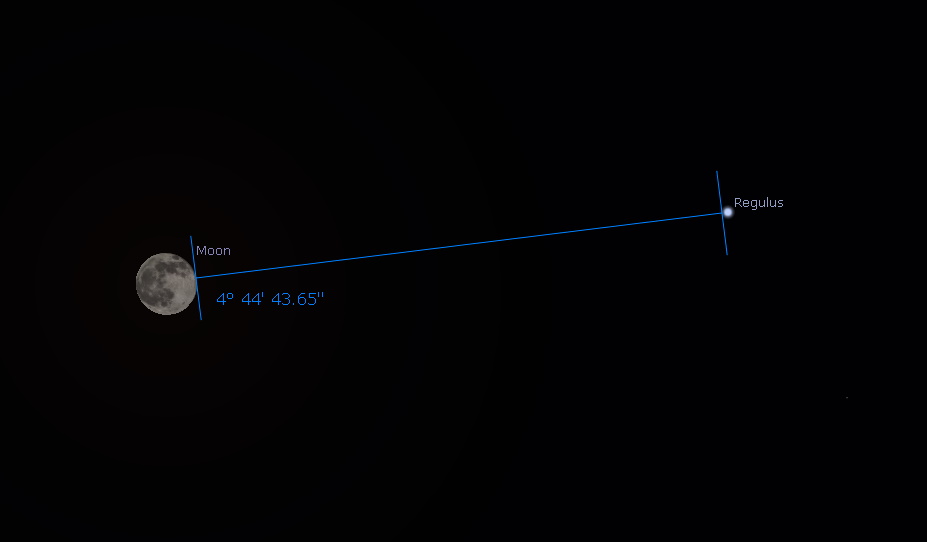 Conjunction of the Moon and the star Regulus high in the southeastern sky at midnight on Feb. 10. Credit: Stellarium / Bob Trembley.
Conjunction of the Moon and the star Regulus high in the southeastern sky at midnight on Feb. 10. Credit: Stellarium / Bob Trembley.Saturn makes a return to the eastern morning sky, joining Jupiter and Mars – Saturn is a bit low on the horizon, and may be lost in the glare of the Sun for several weeks.
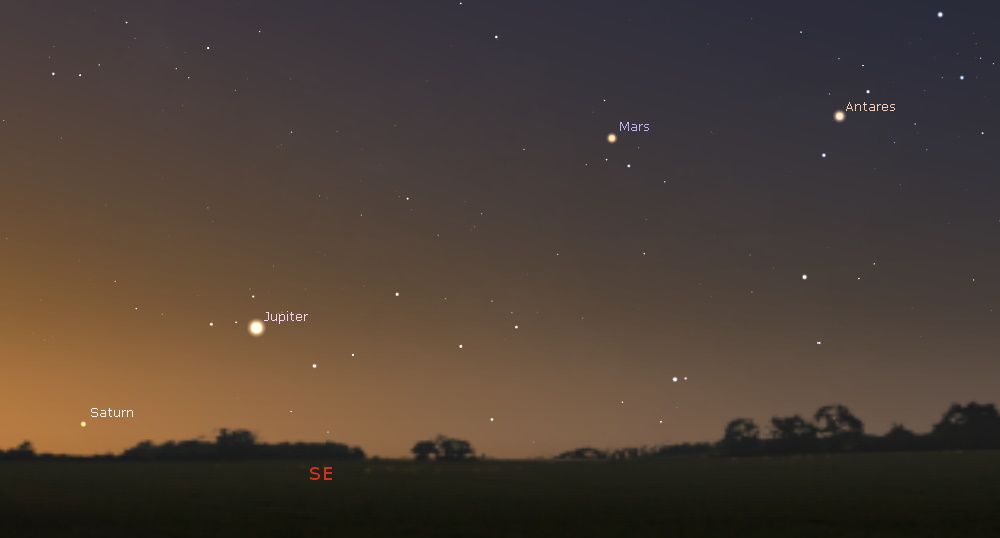 Saturn returns very low on the horizon! Jupiter is low and Mars high above the southeastern horizon at dawn this week. Credit: Stellarium / Bob Trembley.
Saturn returns very low on the horizon! Jupiter is low and Mars high above the southeastern horizon at dawn this week. Credit: Stellarium / Bob Trembley. M 22
M 22
Messier 22 or M22, also known as NGC 6656, is an elliptical globular cluster of stars in the constellation Sagittarius, near the Galactic bulge region. It is one of the brightest globulars that is visible in the night sky. The brightest stars are 11th magnitude, with hundreds of stars bright enough to resolve with an 8″ telescope. M22 is located just south of the Ecliptic, and northwest of Lambda Sagittarii (Kaus Borealis), the northernmost star of the “Teapot” asterism.
M22 was one of the first globulars to be discovered, on August 26, 1665 by Abraham Ihle and it was included in Charles Messier’s catalog of comet-like objects on June 5, 1764. It was one of the first globular clusters to be carefully studied first by Harlow Shapley in 1930. He discovered roughly 70,000 stars and found it had a dense core. Then Halton Arp and William G. Melbourne continued studies in 1959. Because of the large color spread of its red giant branch (RGB) sequence, which is similar to that observed in Omega Centauri, it became the object of intense scrutiny starting in 1977 with James E. Hesser et al.
M22 is one of the nearer globular clusters to Earth at a distance of about 10,600 light-years away. It spans 32′ on the sky which translates to a spatial diameter of 99 ± 9 light-years. 32 variable stars have been recorded in M22. It is projected in front of the galactic bulge and is therefore useful for its microlensing effect on the background stars in the bulge. – Wikipedia
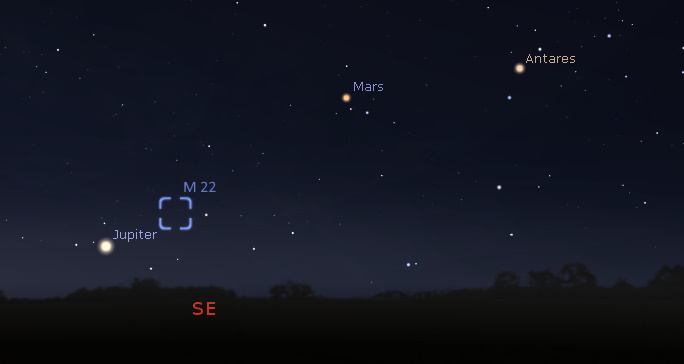 Location of M22 in the southeastern predawn sky this week. Credit: Stellarium / Bob Trembley.
Location of M22 in the southeastern predawn sky this week. Credit: Stellarium / Bob Trembley.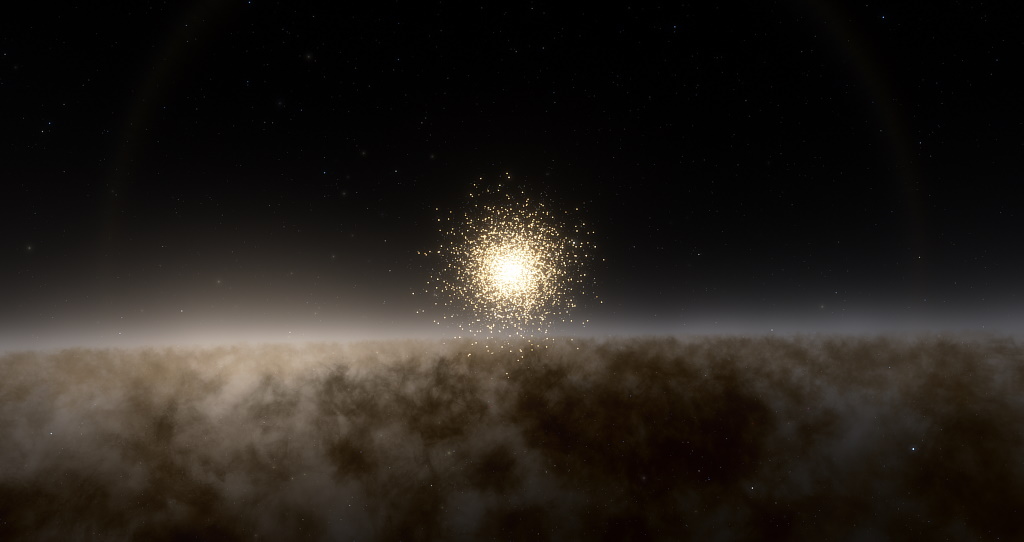 Artist’s conception of M22 seen from above the plane of the Milky Way. Credit: SpaceEngine / Bob Trembley
Artist’s conception of M22 seen from above the plane of the Milky Way. Credit: SpaceEngine / Bob Trembley
The Moon is a waxing gibbous, visible to the southeast in early evening, and up for most of the night.
The full Moon occurs on Sunday Feb. 9, rising at sunset, visible high in the sky around midnight, and up all night.
After Feb. 9 the Moon will be a waning gibbous, rising after sunset, visible high in the sky after midnight, and visible to the southwest after sunrise.
 The Moon from 2020-02-04 – 2020-02-10. Visualizations by Ernie Wright / NASA’s Scientific Visualization Studio.
The Moon from 2020-02-04 – 2020-02-10. Visualizations by Ernie Wright / NASA’s Scientific Visualization Studio.Click this image to go to the NASA 2020 Moon Phase and Libration site. Click the image of the Moon on that site to download a high-rez image of the current Moon phase with the names of craters and other features shown – many along the terminator.
Moon News
https://twitter.com/NASAMoon/status/1224169900568121345

The Sun has been spot-free for 1 day.
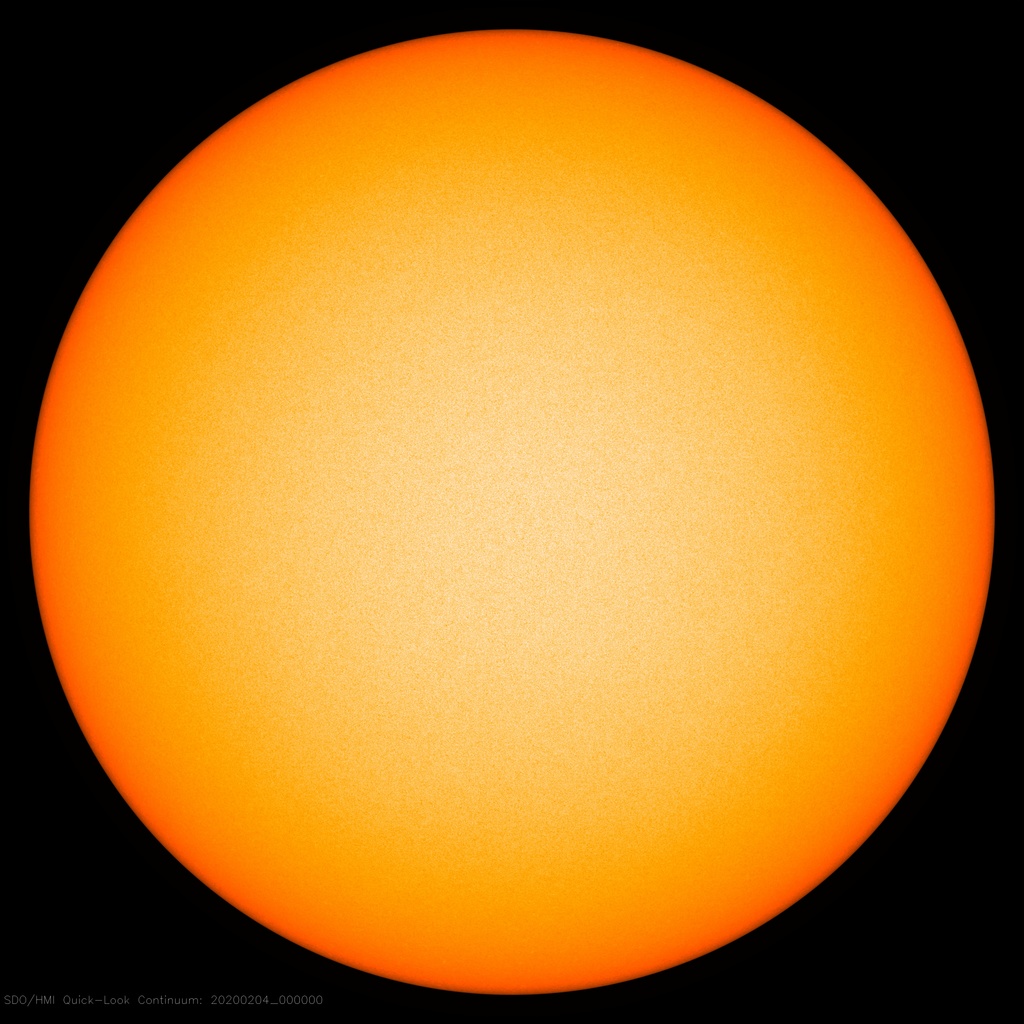 Colored HMI Intensitygram of the Sun from 2020-02-04. Image courtesy of NASA/SDO and the AIA, EVE, and HMI science teams.
Colored HMI Intensitygram of the Sun from 2020-02-04. Image courtesy of NASA/SDO and the AIA, EVE, and HMI science teams.The northern coronal hole remains diminished… but that southern hole has gone from huge to ginormous!
The Sun seen in 193 angstroms (extreme ultraviolet) Feb. 3, 2020:
More awesome prominences on the Sun’s limb over the last several days! Loops and hedgerows galore!
The Sun seen in 304 angstroms (extreme ultraviolet) Feb. 3, 2020:
You can view the Sun in near real-time, in multiple frequencies here: SDO-The Sun Now.
You can create your own time-lapse movies of the Sun here: AIA/HMI Browse Data.
You can browse all the SDO images of the Sun from 2010 to the present here: Browse SDO archive.
Facebook: SolarActivity
https://www.facebook.com/photo.php?fbid=10218988396254616&set=gm.2963635603647764&type=3&theater&ifg=1
Solar Corona
Solar wind speed is 354.3 km/sec (↑), with a density of 6.4 protons/cm3 (↑) at 1257 UT.
Near real-time animation of the corona and solar wind from the Solar & Heliospheric Observatory (SOHO):
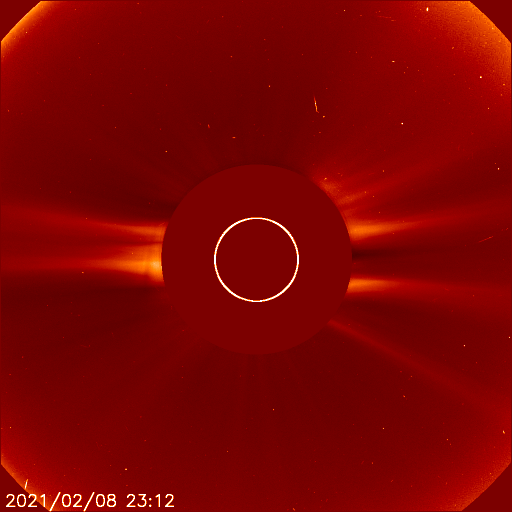 Animated LASCO C2 Coronograph showing the solar corona above the Sun’s limb (the white circle). Credit: NASA/JPL-Caltech-SOHO
Animated LASCO C2 Coronograph showing the solar corona above the Sun’s limb (the white circle). Credit: NASA/JPL-Caltech-SOHOSun News: Most Detailed Images of Granules on the Sun’s Photosphere

Potentially hazardous asteroids: 2018 (last updated Oct. 1, 2019)
Total Minor Planets discovered: 932,034 (+148)
Upcoming Earth-asteroid encounters:
| Asteroid |
Date(UT)
|
Miss Distance
|
Velocity (km/s)
|
Diameter (m)
|
| 2013 BA74 |
2020-Feb-04
|
3.7 LD
|
7.4
|
28
|
| 2020 CO |
2020-Feb-04
|
11.5 LD
|
17.5
|
23
|
| 2020 CN |
2020-Feb-04
|
4.8 LD
|
14.8
|
12
|
| 2020 CR |
2020-Feb-04
|
2.6 LD
|
22.4
|
13
|
| 2020 CC |
2020-Feb-05
|
1.9 LD
|
10.7
|
9
|
| 2020 BR11 |
2020-Feb-05
|
10.5 LD
|
3.2
|
9
|
| 2020 CT |
2020-Feb-05
|
4.3 LD
|
13.2
|
8
|
| 2020 BY13 |
2020-Feb-05
|
10.8 LD
|
9.4
|
28
|
| 2020 BF10 |
2020-Feb-06
|
2.9 LD
|
8.6
|
12
|
| 2020 BF11 |
2020-Feb-07
|
16.8 LD
|
13.9
|
35
|
| 2020 BL8 |
2020-Feb-08
|
6.6 LD
|
3.2
|
25
|
| 2020 BQ11 |
2020-Feb-08
|
14.1 LD
|
21.3
|
46
|
| 2020 BW5 |
2020-Feb-09
|
5.2 LD
|
9
|
18
|
| 2020 BK10 |
2020-Feb-10
|
1.9 LD
|
11.5
|
21
|
| 2020 BC10 |
2020-Feb-10
|
15.2 LD
|
7.5
|
33
|
| 2020 CH |
2020-Feb-12
|
11.6 LD
|
9.4
|
30
|
| 2020 CF |
2020-Feb-12
|
14.8 LD
|
5.3
|
12
|
| 163373 |
2020-Feb-15
|
15.1 LD
|
15.2
|
589
|
| 2020 BL14 |
2020-Feb-16
|
18.1 LD
|
8.8
|
32
|
| 2018 CW2 |
2020-Feb-17
|
6 LD
|
10.2
|
28
|
| 2020 BA10 |
2020-Feb-18
|
12.3 LD
|
9
|
28
|
| 2020 BL7 |
2020-Feb-19
|
13.9 LD
|
8.6
|
36
|
| 2020 BC9 |
2020-Feb-20
|
13.9 LD
|
9.3
|
77
|
| 2019 BE5 |
2020-Feb-20
|
13.7 LD
|
14.8
|
34
|
| 2011 DR |
2020-Feb-23
|
14.7 LD
|
5.8
|
25
|
| 2016 CO246 |
2020-Feb-23
|
18.4 LD
|
5.9
|
25
|
| 2020 BR10 |
2020-Feb-23
|
15.4 LD
|
15.1
|
100
|
| 2020 BW13 |
2020-Feb-24
|
9.1 LD
|
2.4
|
13
|
| 2012 DS30 |
2020-Feb-26
|
12.3 LD
|
5.4
|
22
|
| 2015 BK509 |
2020-Feb-29
|
18.7 LD
|
12.5
|
118
|
| 2017 BM123 |
2020-Mar-01
|
10.5 LD
|
8.1
|
65
|
| 2018 RF6 |
2020-Mar-10
|
11.2 LD
|
12.6
|
36
|
| 2008 UB95 |
2020-Mar-11
|
18.5 LD
|
7.6
|
41
|
| 2018 GY |
2020-Mar-15
|
6.2 LD
|
9.5
|
39
|
| 2012 XA133 |
2020-Mar-27
|
17.4 LD
|
23.7
|
235
|
| 2010 GD35 |
2020-Mar-29
|
15.3 LD
|
 NewsletterUpcoming astronomical events, scientific breakthroughs, philosophical reflections… just a few reasons to subscribe to our newsletter! |
